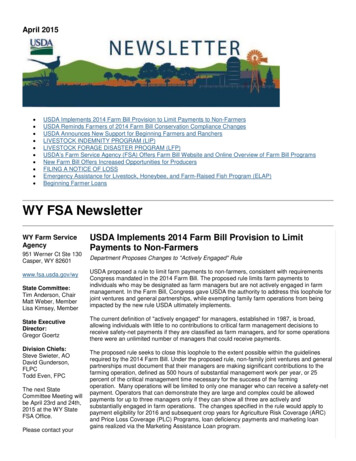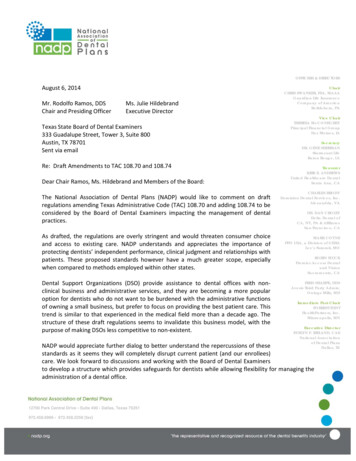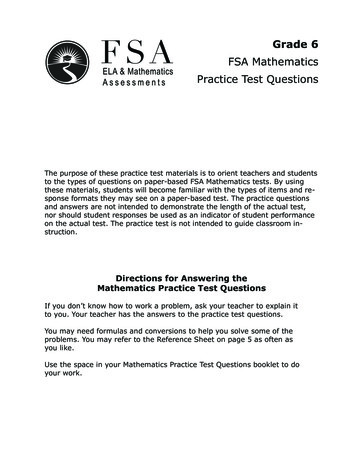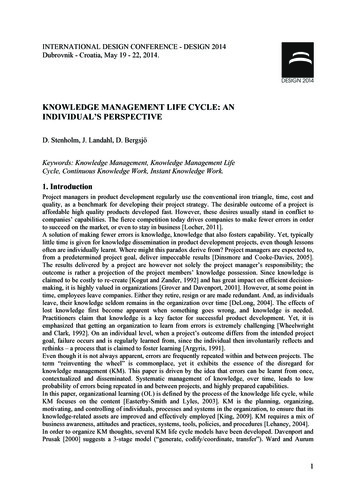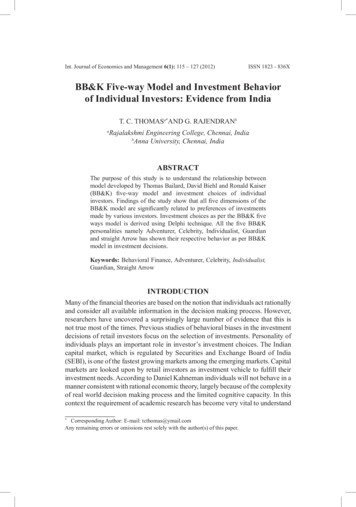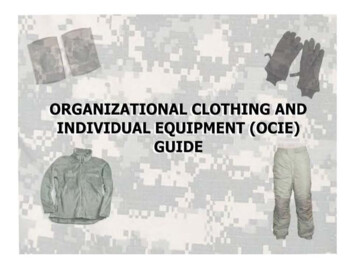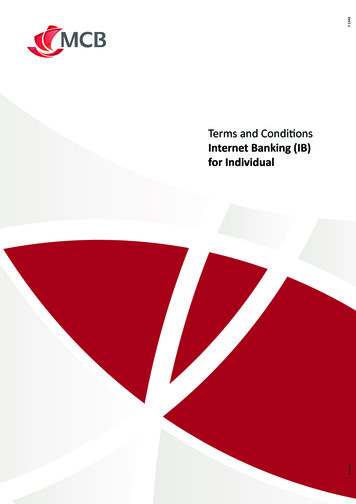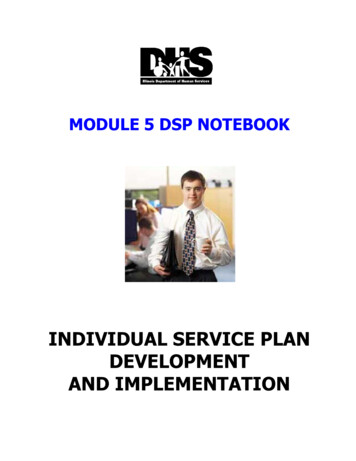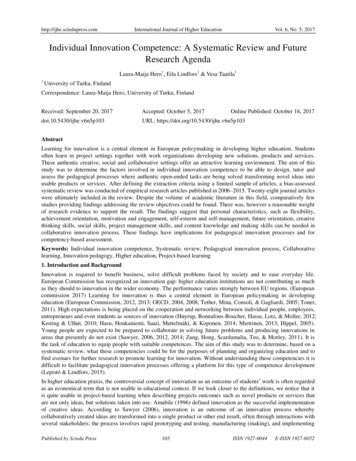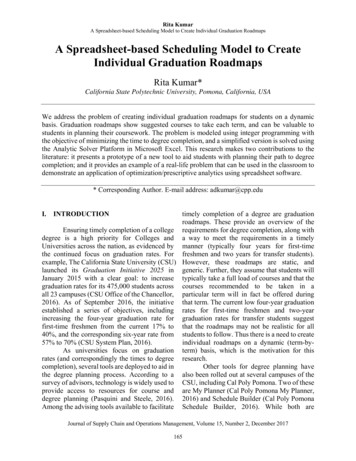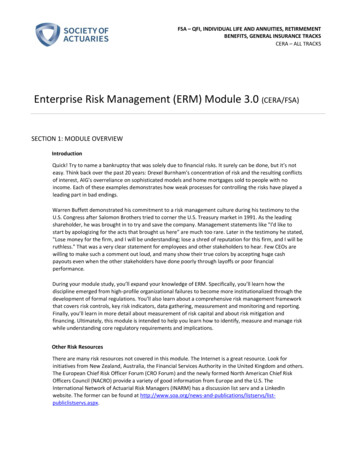
Transcription
FSA – QFI, INDIVIDUAL LIFE AND ANNUITIES, RETIRMEMENTBENEFITS, GENERAL INSURANCE TRACKSCERA – ALL TRACKSEnterprise Risk Management (ERM) Module 3.0 (CERA/FSA)SECTION 1: MODULE OVERVIEWIntroductionQuick! Try to name a bankruptcy that was solely due to financial risks. It surely can be done, but it’s noteasy. Think back over the past 20 years: Drexel Burnham’s concentration of risk and the resulting conflictsof interest, AIG’s overreliance on sophisticated models and home mortgages sold to people with noincome. Each of these examples demonstrates how weak processes for controlling the risks have played aleading part in bad endings.Warren Buffett demonstrated his commitment to a risk management culture during his testimony to theU.S. Congress after Salomon Brothers tried to corner the U.S. Treasury market in 1991. As the leadingshareholder, he was brought in to try and save the company. Management statements like "I'd like tostart by apologizing for the acts that brought us here” are much too rare. Later in the testimony he stated,"Lose money for the firm, and I will be understanding; lose a shred of reputation for this firm, and I will beruthless." That was a very clear statement for employees and other stakeholders to hear. Few CEOs arewilling to make such a comment out loud, and many show their true colors by accepting huge cashpayouts even when the other stakeholders have done poorly through layoffs or poor financialperformance.During your module study, you’ll expand your knowledge of ERM. Specifically, you’ll learn how thediscipline emerged from high-profile organizational failures to become more institutionalized through thedevelopment of formal regulations. You’ll also learn about a comprehensive risk management frameworkthat covers risk controls, key risk indicators, data gathering, measurement and monitoring and reporting.Finally, you’ll learn in more detail about measurement of risk capital and about risk mitigation andfinancing. Ultimately, this module is intended to help you learn how to identify, measure and manage riskwhile understanding core regulatory requirements and implications.Other Risk ResourcesThere are many risk resources not covered in this module. The Internet is a great resource. Look forinitiatives from New Zealand, Australia, the Financial Services Authority in the United Kingdom and others.The European Chief Risk Officer Forum (CRO Forum) and the newly formed North American Chief RiskOfficers Council (NACRO) provide a variety of good information from Europe and the U.S. TheInternational Network of Actuarial Risk Managers (INARM) has a discussion list serv and a LinkedInwebsite. The former can be found at /listpubliclistservs.aspx.
FSA: ENTERPRISE RISK MANAGEMENT (ERM) MODULE 2013 Society of Actuaries1Regulatory RegimesRegulators continue to evolve their risk management requirements. Most regimes are moving from beingrules-based where formulas are applied to current exposures, to principles-based approaches (PBA). PBAtechniques borrow heavily from those used for ERM, so the practitioner is able to leverage toolsdeveloped for one purpose and apply them to another.Module ObjectivesAfter you complete this module, you will be able to: Explain what enterprise risk management (ERM) means.Describe an ERM framework.Identify regulatory requirements related to ERM.Define, identify and evaluate operational risks.Understand data issues in general, and special considerations with respect to ERM.Describe and apply quantitative and qualitative methods for assessing risk.Describe and apply the components of an effective economic capital model.Module SectionsThis module consists of nine sections: Section 1. Module Overview (You are here now). Section 2. Introduction to Enterprise Risk Management. Section 3. Developing an ERM Framework. Section 4. Regulatory Requirements. Section 5. Defining, Identifying and Evaluating Operational Risks. Section 7. Risk Measurement Approaches. Section 8. Economic Capital. Section 9. Putting it all Together.Section 6. Data Issues.In addition, this module contains an End-of-Module Test and an End-of-Module Exercise.SECTION 2: INTRODUCTION TO ENTERPRISE RISK MANAGEMENTIntroduction - Emergence of a New DisciplineUntil relatively recently, risk management was not considered to be a separate discipline, even in thefinancial services industry. While companies had long managed operational risks in addition to credit andmarket risks, several high-profile failures prompted organizations to begin to approach all risk moreformally and systematically. 2016 Society of Actuaries. All Rights Reserved.Enterprise Risk Management 3.0 Module Objectives.DocxEnterprise Risk Management Module 3.0 Objectives2
FSA: ENTERPRISE RISK MANAGEMENT (ERM) MODULEThere are a variety of ways to define risk categories. Later, this module focuses on alternative riskdefinitions, especially regarding operational risk. While the traditional definition of financial risk includescredit risk and market risk, categories such as strategic risk are not handled consistently by regulatoryregimes.ObjectivesUpon completion of Section 2, you should be equipped with the basics to leverage single risk models toreview risks consistently at the enterprise level.After you complete this section, you will be able to: Understand the set of risk taxonomies and apply it to different frameworks. Explain the need for risk management in an operation-wide capacity. Describe the implications of tail events on a firm’s results. Explain how banks, insurers, pension plans (or financial intermediaries) and rating agenciesdefine risk. Identify the drivers behind some well-publicized insolvencies.SECTION 3: DEVELOPING AN ERM FRAMEWORKIntroductionRisk management forces firms, and individuals, to think about what risks they are taking. It alsoencourages them to think about which risks they want to take because they expect to be paid adequatelyto accept the risk. Then they can act on the two.Most people think about risk management as mitigation, how to reduce a risk that is already on thebooks. But, in addition, firms must determine whether to accept the risk in the first place, and whether toseek out a risk. This allows a firm to optimize its risk profile through strategic and tactical planning.ObjectivesAfter you complete Section 3, you will be able to: Evaluate an ERM framework.Use tools common to ERM practice.Use common sense to consider models and their results.Present a list of risks and prioritize them for a specific firm. 2016 Society of Actuaries. All Rights Reserved.Enterprise Risk Management 3.0 Module Objectives.DocxEnterprise Risk Management Module 3.0 Objectives3
FSA: ENTERPRISE RISK MANAGEMENT (ERM) MODULESECTION 4: REGULATORY AND RATING AGENCY PERSPECTIVESIntroductionIn recent years, and in particular as a result of the 2008 financial crisis, regulators across the globe have takenaction to increase supervision of insurers and financial institutions. This increased supervision has promotedcapital adequacy assessments and has encouraged stronger Enterprise Risk Management activities within theorganizations being supervised.In addition, rating agencies have been increasingly focused on the understanding the strength of insurers’ riskmanagement programs.ObjectivesAfter you complete Section 4, you will be able to: Understand the role that related banking regulation has played in the development ofinsurance regulation for risk management.Describe global regulatory initiatives as they relate to ERM.Describe European, U.S., and Canadian ERM regulatory initiatives in more detail.Describe rating agency expectations for ERM.SECTION 5: DEFINING, IDENTIFYING AND EVALUATING OPERATIONAL RISKSIntroductionIn section 5, you will review many aspects of operational risk and their link to the broader context of ERM.ObjectivesAfter you complete Section 5, you will be able to: Define and understand the traditional regulatory and broader operational risk approaches. Describe major sources of operational risk in general and their link to other risks such asreputational risk from an ERM perspective. Understand the use of qualitative approaches such as key risk indicators for risks that do not lendthemselves easily to quantification. Compare and contrast different approaches to quantitatively evaluate operational risk; includingthe “actuarial method” approach. Describe at least two hedging strategies including control effectiveness and insurance. 2016 Society of Actuaries. All Rights Reserved.Enterprise Risk Management 3.0 Module Objectives.DocxEnterprise Risk Management Module 3.0 Objectives4
FSA: ENTERPRISE RISK MANAGEMENT (ERM) MODULESECTION 6: DATA ISSUESIntroductionUnderstandably, actuaries spend a great deal of time thinking about models, their construction andevaluation, and their results. They often spend less time thinking about data requirements. When theproject begins, it often turns out that collecting and validating the data takes far more time thananticipated. But “Garbage in, garbage out.”ObjectivesAfter you complete this section, you will be able to: Explain the guidance related to data issues provided by actuarial standards of practice in Canadaand the U.S. Identify and describe the key general considerations related to data and data validation. Define categories of data relevant to ERM. Explain the uses and misuses of internal data. Consider how to handle suboptimal data. Identify important considerations in communication of data issues.SECTION 7: RISK MANAGEMENT APPROACHESIntroduction and ObjectivesSection 7 will focus on the common tools used for measuring risk and assessing the effect of unexpectedevents. Understand how strong risk management practices can help better prepare companies forunexpected events.Describe how unexpected events can be assessed using extreme value theory, predictivemodeling and scenario generators.Understand copula models as a way to represent risk interactions.Explain how scenario analysis can add value to ERM and discuss several methods for constructingscenarios.Integrate many aspects of ERM discussed to this point. 2016 Society of Actuaries. All Rights Reserved.Enterprise Risk Management 3.0 Module Objectives.DocxEnterprise Risk Management Module 3.0 Objectives5
FSA: ENTERPRISE RISK MANAGEMENT (ERM) MODULESECTION 8: ECONOMIC CAPITALIntroductionEconomic capital is an important enterprise risk management tool that assists companies in evaluatingand managing their existing and potential risks. Economic capital can enhance strategic decision making,both by improving the understanding of individual risk exposures and by better appreciating therelationships between risks. This holistic perspective aligns economic capital with many of the ERMprinciples that have been introduced in earlier sections.ObjectivesAfter you complete Section 8, you will be able to: Define and use economic capital in enterprise risk management (ERM). Describe the value of economic capital in enterprise risk management (ERM). Describe the elements of an economic capital model. Describe a process for developing an economic capital model. Develop an economic capital model. Describe the advantages and disadvantages of various economic capital models. 2016 Society of Actuaries. All Rights Reserved.Enterprise Risk Management 3.0 Module Objectives.DocxEnterprise Risk Management Module 3.0 Objectives6
FSA: ENTERPRISE RISK MANAGEMENT (ERM) MODULESECTION 9: ERM AND STRATEGIC PLANNINGIntroductionThis section will discuss many of these items in the context of strategic planning. We will see how ERM can be usedto provide a firm with a competitive advantage. Traditional views on risk management may focus on mitigating theimpact of adverse events, but ERM recognizes that a holistic perspective can identify areas in which taking risk canlead to positive outcomes.The components we’ve considered in previous sections include: Risk management culture Risk identification and control processes Regulatory and rating agency considerations Data Challenges Extreme event management Risk models and capital modelsObjectivesOptimization of the risk and reward relationship is the key to strategic planning. Prioritization of resourcesto address all types of risks, leveraging existing projects, will implement the SOA motto, “Risk isOpportunity.”After you complete this section, you will be able to: Explain how various strategic planning alternatives would affect risks taken and results achieved.Propose solutions to exploit risk knowledge.Describe how company size can affect effective ERM strategies.Discuss the future of risk management theory and techniques.Leverage existing tools for use in ERM and strategic planning.Discuss the challenges facing someone setting up a risk unit.END-OF-MODULE TEST END-OF-MODULEEXERCISE 2016 Society of Actuaries. All Rights Reserved.Enterprise Risk Management 3.0 Module Objectives.DocxEnterprise Risk Management Module 3.0 Objectives7
insurance regulation for risk management. Describe global regulatory initiatives as they relate to ERM. Describe European, U.S., and Canadian ERM regulatory initiatives in more detail. Describe rating agency expectations for ERM. SECTION 5: DEFINING, IDENTIFYING AND EVALUATING OPERATIONAL RISKS Introduction
